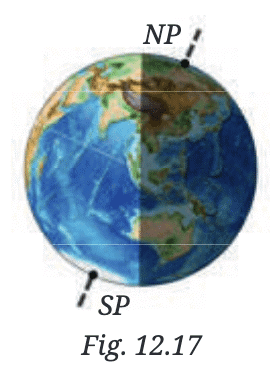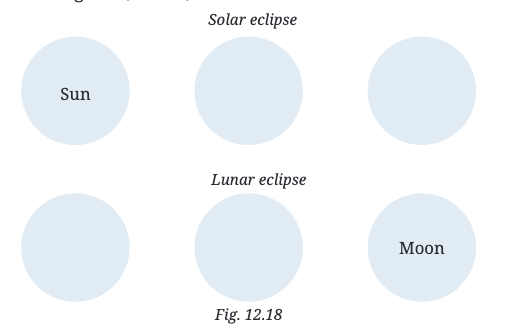NCERT Solutions for Class 7 Science Chapter 12 Earth, Moon, and the Sun
Let Us Enhance Our Learning
Q1: In Fig. 12.17, how many hours of sunlight do the North Pole and the South Pole receive during one rotation of the Earth?
Ans: During one rotation of the Earth, the North and South Poles experience 24 hours of either sunlight or darkness, depending on the season. This is because the Earth's axial tilt causes these poles to either face the sun constantly (24 hours of sunlight) or be completely shielded from the sun (24 hours of darkness) for periods of several months.
According to the figure, the South Pole is receiving 24 hours of sunlight, while the North Pole is in complete darkness.
Q2: Fill in the blanks
(i) Stars rise in the _________ and set in the ___________.
Ans: Stars rise in the East and set in the West.
(ii) Day and night are caused by the Earth’s __________________.
Ans: Day and night are caused by the Earth’s rotation.
(iii) When the Moon fully covers the Sun from our view, it is called a _____________ solar eclipse.
Ans: When the Moon fully covers the Sun from our view, it is called a total solar eclipse.
Q3: State whether True or False
(i) Lunar eclipse occurs when the Sun comes between the Earth and the Moon.
Ans: False
A lunar eclipse happens when the Earth is between the Sun and the Moon. This causes the Earth's shadow to fall on the Moon, blocking the Sun's light.
(ii) Sunrise happens earlier in Gujarat than in Jharkhand.
Ans: True
Gujarat is located to the west of Jharkhand, so the Sun rises earlier in Gujarat because of its position relative to the Earth’s rotation.
(iii) In Chennai, the longest day occurs on the summer solstice.
Ans: True
The longest day of the year happens on the summer solstice, which occurs around June 21st. Chennai, being in the Northern Hemisphere, experiences its longest day during this time.
(iv) We should watch the solar eclipse directly with our naked eye.
Ans: False
Looking at a solar eclipse directly without protective glasses can damage your eyes, as the Sun's rays are harmful.
(v) Seasons occur due to the tilt of Earth’s axis of rotation and its spherical shape.
Ans: True
The tilt of the Earth's axis and its spherical shape cause the Sun's rays to hit different parts of the Earth at different angles throughout the year, creating the four seasons.
(vi) The Earth’s revolution around the Sun causes day and night.
Ans: False
Day and night are caused by the Earth’s rotation on its axis, not its revolution around the Sun. The Earth rotates, creating the cycle of day and night.
Q4: Padmashree saw the Orion constellation nearly overhead at 8 pm yesterday. When will she see Orion overhead today?
Ans: She will see Orion overhead approximately 4 minutes earlier each day due to the Earth's rotation and revolution.
Q5: Nandhini saw a group of stars rising at midnight on 21 June. When will she see the same group of stars rising at midnight next year?
Ans: Nandhini will see the same group of stars rising at midnight on 21 June next year as well, since the Earth completes one full revolution around the Sun in about 365 days, so the position of the stars is similar each year.
Q6: Abhay noticed that when it was daytime in India, his uncle who was in the USA was generally sleeping as it was night-time there. What is the reason behind this difference?
Ans: This difference is due to the Earth’s rotation. As the Earth rotates, different parts of the world experience day and night at different times. India and the USA are in different time zones.
Q7: Four friends used the following ways to see the solar eclipse. Who among them was being careless?
(i) Ravikiran used a solar eclipse goggle.
Ans: Safe
(ii) Jyothi used a mirror to project the Sun’s image.
Ans: Safe
(iii) Adithya saw the Sun directly with his eyes.
Ans: Careless
(iv) Aruna attended a programme arranged by a planetarium. Safe
Q8: Fill in the circles in Fig. 12.18 appropriately with one of the following: Sun, Moon, Earth.
Ans:
Solar Eclipse: Sun - Moon - Earth
Lunar Eclipse: Sun - Earth - Moon
Q9: The Moon is much smaller than the Sun, yet it can block the Sun completely from our view during a total solar eclipse. Why is it possible?
Ans: The Moon can block the Sun completely during a total solar eclipse because it is much closer to the Earth than the Sun. The apparent sizes of the Moon and the Sun are similar when viewed from Earth.
Q10: The Indian cricket team matches in Australia are often held in December. Should they pack winter or summer clothes for their trip?
Ans: The Indian cricket team should pack summer clothes for their trip to Australia in December because, in the Southern Hemisphere, December is summer. While India experiences winter during this time, Australia has warm weather, so they will need light and comfortable clothing suitable for summer.
Q11: Why do you think lunar eclipses can be seen from a large part of the Earth when they happen, but total solar eclipse can be seen by only a small part of the Earth?
Ans: Lunar eclipses are visible from a larger part of the Earth because the Earth’s shadow is large, and it covers a wide area. A solar eclipse, however, is visible only from a small part of the Earth because the Moon’s shadow is much smaller and concentrated in specific regions.
Q12: If the Earth’s axis were not tilted with respect to the axis of revolution, explain what would be the effect on seasons?
Ans: If the Earth's axis were not tilted, there would be no seasonal changes. The amount of sunlight received at different latitudes would remain the same throughout the year, leading to a uniform climate year-round.
|
80 videos|321 docs|12 tests
|
FAQs on NCERT Solutions for Class 7 Science Chapter 12 Earth, Moon, and the Sun
| 1. What are the main differences between the Earth, Moon, and Sun? |  |
| 2. How does the Moon affect the Earth? |  |
| 3. What causes the different phases of the Moon? |  |
| 4. Why do we always see the same side of the Moon? |  |
| 5. What is the role of the Sun in the solar system? |  |
















